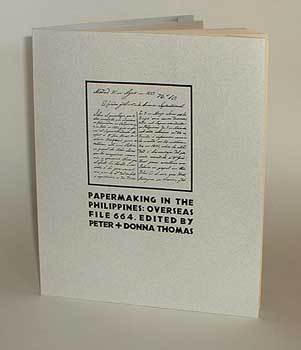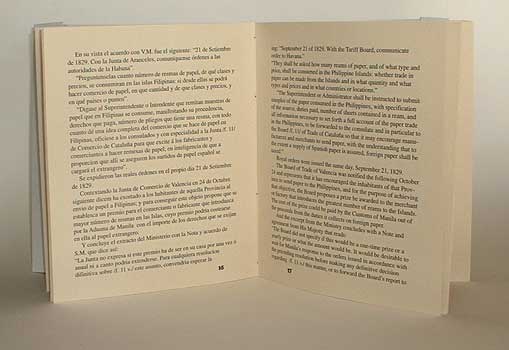PETER & DONNA THOMAS
 260 Fifteenth Avenue Santa Cruz CA 95062 (831)
475-1455
260 Fifteenth Avenue Santa Cruz CA 95062 (831)
475-1455
Papermaking in the Philippines: Overseas File 664 from the Archivo General de Indias, Sevilla, Spain. (2005) Edited by Peter Thomas. 8 1/8 by 7 1/8 inches, 36 pages. This is the full translation of the text referred to in Appendix One to our History of Papermaking in the Philippines. It was transcribed from the original handwritten documents held in the Archivo General de Indias, in Sevilla, Spain. The document relate to the efforts of Jose Huet to set up a paper mill in the Philippines in the 1820s, and has the Spanish transcription on the verso and the English translation on the recto. Included are three digital illustrations reproducing linocuts by Donna Thomas. The book has been laser printed on high quality commercial copy paper, hand sewn and non-adhesive bound in a paper case; the title and a reduced reproduction of a page from the original manuscript are printed on the cover. $75.
If you are only interested in the text, and don't really want the book, I will be happy to send the text to you as a .doc file.



I first contacted the Archivo in 1992, at the suggestion of William Scott,
who mentioned they might have documents related to the 1825 papermaking venture
mentioned in Emma Blair and J. A. Robertson’s The Philippine Islands,
1493-1803, edited by . Since I cannot speak or write much Spanish, so this
was a very difficult task. I found they did have some documents and enlisted
the help of Victoria Rabal Merola, director the Paper Museum in Capellades,
Spain, to bring them to me when we met for a conference of the International
Association of Hand Papermakers and Paper Artists (IAPMA) in Holland.
The documents I received were bad photocopies of the nineteenth century manuscripts
with antiquated writing and obscure words, so the documents had to be transcribed
and converted to modern Spanish before they could be translated. Before fax
and e-mail and without a command of Spanish, this wasa daunting task. Victoria
did much of the initial transcription, and Loreto Apilado lent assistance
from the Philippines in the attempt to make sense of the documents. Even with
information missing, I could tell that Huet had in fact made paper, and with
this information in hand, I began printing the book.
It was only after I had already printed some of the pages of our book, The
History of Papermaking in the Philippines, the pages that told of Huet’s
papermaking, that I realized I had not been enough of a scholar: I really
needed to make a better attempt to find all of the documents and if possible,
samples of the paper made by Huet. I stopped printing the book and began to
try to find more information, slowly, for years. In 2002 a breakthrough came.
With the assistance of e-mail, I found a scholar who worked regularly with
the collection in the Archivo, Francisco Sánchez, who located and transcribed
the complete document into Spanish. With the help of colleagues, both in the
USA and abroad, and then a professional translator, it was translated into
English. In the end the mystery is still there. I know paper was made by hand
in the Philippines in the 1820-30s, as the documents state that samples were
sent to Spain, but I did not find the samples. Perhaps they are in the Archivo,
but locating them will be a project for a better scholar than I.
Colophon
This book was formatted on an iMac G3 desktop using PageMaker 6.0. The type
faces are Times and Neuland. The file was "booklet-tized" and then
"kinkoed" (laser printed) at Kinkos. The paper is commercial copy
paper. The book has been handbound by Peter and Donna Thomas. The edition
is not limited. The printing history is noted with the copyright information,
on the back of the title page, and each copy is sequentially numbered.
![]() 260 Fifteenth Avenue Santa Cruz CA 95062 (831)
475-1455
260 Fifteenth Avenue Santa Cruz CA 95062 (831)
475-1455
